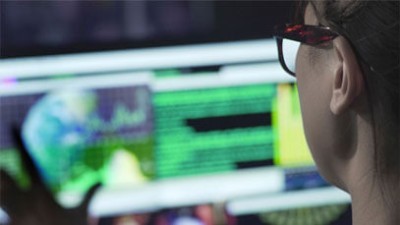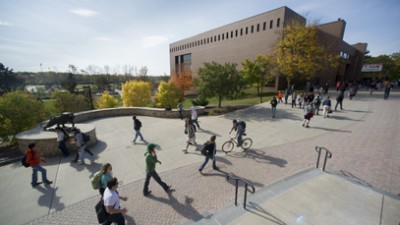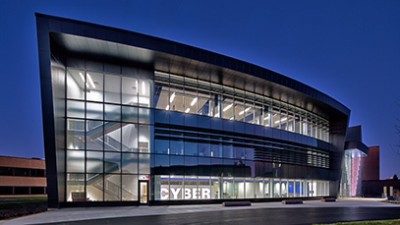News
Department of Computing and Information Sciences Ph.D.
-
March 10, 2023
![four college students posing for a photo at a conference.]()
Students benefit from interdisciplinary work during Emerging Creatives Student Summit
Students across the country, including four from RIT, came together last weekend to explore the question ‘what do we want our future to look like?’ during the Alliance for the Arts in Research Universities (a2ru) Emerging Creatives Student Summit.
-
February 15, 2023
![person wearing a microphone and talking.]()
‘Wild West’ ChatGPT has ‘fundamental flaw’ with left bias
The New York Post talks to Pengcheng Shi, associate dean for research and scholarship and director of the Ph.D. program in the Golisano College of Computing and Information Sciences, about the chatbot ChatGPT.
-
January 25, 2023
![laptop with an internet browser open and showing a webpage about open A.I.]()
ChatGPT could make these jobs obsolete: ‘The wolf is at the door’
The New York Post talks to Pengcheng Shi, associate dean for research and scholarship and director of the Ph.D. program in the Golisano College of Computing and Information Sciences, about the chatbot ChatGPT.
-
December 8, 2022
![researchers wearing clean suits in a lab.]()
K-12’s Army Educational Outreach Program connects students with research opportunities nationwide
The K-12 University Center at RIT& runs the Apprenticeships and Fellowships division of the Army Educational Outreach Program (AEOP), helping high school students through post-doctoral students find positions at research labs and centers affiliated with the U.S. Army and with universities across the U.S.
-
October 5, 2022
![graphic reads, Saad Hassan, computing and information sciences Ph.D. student.]()
Researching at the intersection of computing and accessibility
Ph.D. student Saad Hassan believes that accessibility should be a primary focus of technological innovation, not an afterthought. He recently received a grant from language-learning company Duolingo to fund his doctoral thesis on look-up systems for unfamiliar signs in languages like American Sign Language.
-
June 3, 2022
![woman using sign language.]()
The opportunity at home: Can AI drive innovation in personal assistant devices and sign language?
The Microsoft Accessibility Blog features a project led by computing and information sciences Ph.D. candidate Abraham Glasser that looks at improving common interactions with smart assistants for people who use sign language.
-
March 31, 2022
![student posing with research poster.]()
RIT’s Graduate Showcase celebrates scholarship April 7
From robot waiters to river otters, RIT’s Graduate Showcase will cover a wide variety of topics representing graduate scholarship from the university’s Henrietta and global campuses. The symposium, held April 7, will feature oral presentations in the morning and poster presentations, demonstrations, and visual exhibitions in the afternoon.
-
March 28, 2022
![man standing in a factory looking a giant rolls of paper.]()
Sappi to work with RIT researchers to advance digital innovation
Computing researchers at RIT are teaming up with Sappi, the leading global provider of sustainable woodfibre products and bio-based solutions, to improve innovation processes. Sappi is funding research to establish the Sappi–RIT Digital Innovation Lab in RIT’s Golisano College of Computing and Information Sciences.
-
January 31, 2022
![logo for the National Science Foundation.]()
Scholars earn coveted early career awards
Three faculty members who chose to start their research careers at RIT received prestigious National Science Foundation CAREER Awards in 2021. Their research aims to advance the foundations of machine intelligence, artificial intelligence, and clean energy.
-
December 6, 2021
![the Vela pulsar, a rapidly rotating neutron star.]()
RIT scientists develop machine learning techniques to shed new light on pulsars
New machine learning techniques developed by scientists at Rochester Institute of Technology are revealing important information about how pulsars—rapidly rotating neutron stars—behave. In a new study published by Monthly Notices of the Royal Astronomical Society, the researchers outlined their new techniques and how they applied to study Vela, the brightest radio pulsar in the sky.
-
December 1, 2021
![exterior of Golisano Computing building at dusk.]()
From floppy disks to the cloud
In 2001, the dot-com bubble was bursting and investors had lost confidence in internet companies. Twenty years later, data has become a new currency, and people can access just about anything from their smartphones. Throughout all these changes, Golisano College of Computing and Information Sciences has evolved into the largest college at RIT, with more than 4,600 students this year. Since its creation 20 years ago, GCCIS has awarded more than 14,000 degrees—in a growing number of computing disciplines.
-
July 21, 2021
![Rui Li, assistant professor, Golisano College of Computing and Information Sciences.]()
Rui Li earns NSF CAREER Award to create machine intelligence that can grow and adapt
Rui Li, an assistant professor in RIT’s Ph.D. program in computing and information sciences, received a NSF Faculty Early Career Development (CAREER) Award and grant to develop machine intelligence that can actually grow when given new information.
















